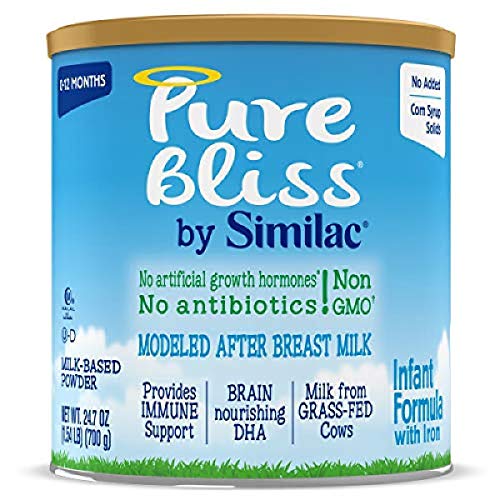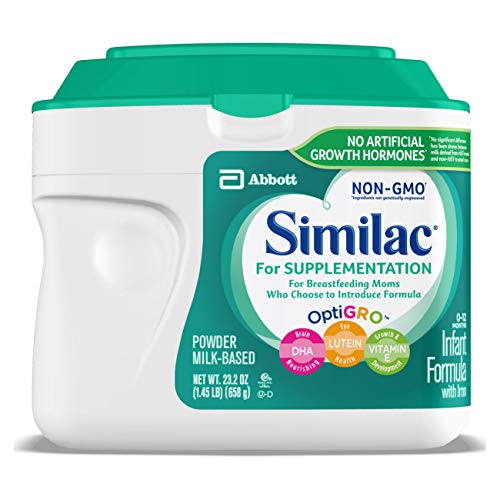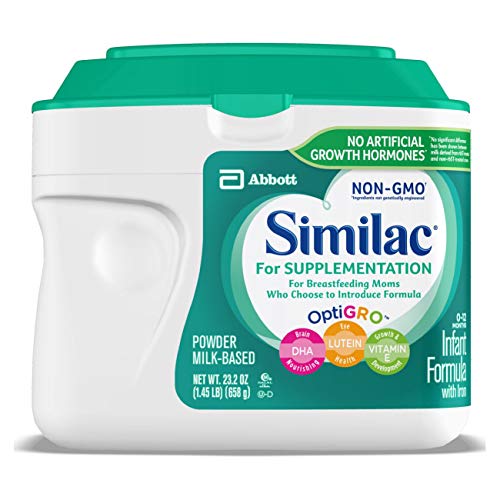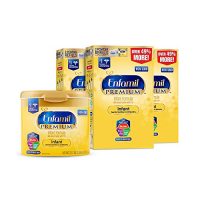Editor’s Note
As of May 2022, many formulas have become increasingly difficult to find. Please read our article, What To Do If You Can’t Find Baby Formula, for more information regarding the formula shortage.
Unfortunately, Similac has discontinued their Supplemental Formula, however, there are other options if you want to occasionally supplement breastfeeding with formula. One of the closest options they offer to breast milk is their Pure Bliss Infant Formula. While this formula is not organic, it starts with fresh milk from grass-fed cows in Ireland and offers no artificial growth hormones and it is non-GMO. Pure Bliss uses lactose as its primary source of carbohydrate energy rather than corn syrup. Pure Bliss offers ingredients for brain and eye development, such as DHA and ARA.
If you are a mom who breastfeeds and occasionally or even daily needs to supplement with formula, you might want to try Similac for Supplementation Formula.
While it’s made for supplementing, the real question is if it’s worth the cost to buy a specific formula for supplementing or if it’s a marketing gimmick to get extra money out of breastfeeding moms.
Take a look at all the information and find out if you need this formula to help feed your baby.
Is Similac for Supplementation Worth It?
Key Features of Similac Supplemental Formula
The main feature of Similac for Supplementation Formula is it’s designed for breastfeeding moms who want to supplement. That’s it- the entire goal of the product is to provide what your baby needs and give you an alternative option to breastfeeding.
Also, it’s meant to still provide support for baby’s brain and eye development. The formula is made with prebiotics to help provide a gentle introduction to formula.
While breastmilk provides many more ingredients, supplemental formula offers everything your babies needs with a cow milk base. Formula does not offer as many ingredients, but allows for a viable option for moms with low milk, or who need to allow someone else to feed the baby when they are not around.
One of the key differences between breastmilk and formula is that the latter takes longer to digest, which gives moms more time between feedings. If you want a formula with ingredients found in breastmilk, consider the Similac Pro-Advance, as it offers 2′-FL HMO which is otherwise only found in breastmilk.
GMOs
Some good news about Similac Supplemental Formula – it’s both non-GMO and free of artificial growth hormones. However, this formula is not organic like breastmilk, which is basically the ultimate natural food with the correct ingredients specific to your baby’s nutritional needs.
If you want an organic formula, try the Similac Organic Formula, which is USDA organic, non-GMO, and free of growth hormones as well. However, it does have maltodextrin, which can cause blood sugar spikes and even reduce the effectiveness of probiotics, among other problems.
Ingredients
To really understand this formula, we need to take a closer look at the components of Similac for Supplementation.
Nutritional Information
All measurements for the formula are based on a serving size of 5.3 fluid ounces, as that is the recommended serving size. Each serving contains 100 calories, 2.07 grams of protein, 5.60 grams of fat, 10.8 grams of carbohydrates, 141 grams of water, and 1000 mg of linoleic acid. We will break these down further for a better understanding, but do note these amounts and ratios are as similar as possible to breastmilk.
Fats
Human breastmilk contains roughly 50 percent fat for baby’s needs. Fat is a necessity as it helps with growth overall and brain growth specifically. The difference between human milk and cow-based baby formula is the taste, smell, and consistency.
Breastmilk is creamy but provides about the same amount of fat as formula. To get the fat, though, formulas need to use plant-based fats, as most babies have a hard time breaking down full-fat cow’s milk since it’s made for baby cows and not baby humans. Oils are an easy to digest option when breastmilk isn’t available.
One great advantage of Similac formula is they do not use palm oil as one of the main fats. Instead, they use high oleic safflower oil, soy oil, and coconut oil. Palm oil is controversial because it’s rough on baby intestines and reduces the absorption of calcium.
Coconut oil is easily digested, and it’s a medium-chain triglyceride, making it an easy to absorb form of energy. Soy often causes controversy, and yet it shows up in practically every baby formula, and like palm oil, it can disrupt calcium absorption, which this formula addresses with extra calcium.
Similac Supplemental formula also offers DHA and ARA as part of the Optigrow for brain and eye development. It’s an omega-fatty acid ready to turn your baby’s brain into a strong machine ready to learn. In the formula, it’s listed as C.Chonii oil and M. Alpina Oil.
Do note that DHA and ARA can cause severe gastrointestinal issues in babies with sensitive tummies.
Prebiotics and Probiotics
Prebiotics and probiotics are like an army for your gut. However, the army is made up of bacteria, and in this formula, you only get a prebiotic. Most baby formulas do not offer probiotics like breastmilk, and this one does not either. You can purchase baby probiotics separately to add to the formula.
In Similac supplemental formula, you get galactooligosaccharides to help your baby with digestive health.
If you want a formula with both prebiotics and probiotics, then you need to get Gerber GentlePro or Soothe.
Protein
Babies, like other humans, need protein to build muscles, which they will need to control their bodies. In Similac for Supplementation formula, you get nonfat milk and whey protein concentrate as the main sources of protein.
While both of these are healthy for your baby, the whey protein concentrate is not hydrolyzed. This means it isn’t partially broken down to make it easier for your baby to digest. You will find this mostly in gentle formula varieties like Similac Total Comfort or Similac Sensitive.
Breastmilk makes proteins an infant can easily break up. However, cow milk does not break up as easily, which is why some formulas do a little of the work for the baby. Moreover, hydrolyzed protein is less likely to cause an allergic reaction in babies, including fewer skin conditions such as eczema.
Carbohydrates and Sugars
In human breastmilk, your baby gets lactose. It’s the same in cow milk, but of course, it’s made for a baby cow and not a baby human. However, it’s an acceptable replacement and in Similac for Supplementing it’s the second ingredient.
Many formulas use other, less desirable ingredients as the main source of carbs and sugars, mainly corn syrup or maltodextrin. Both of these ingredients can spike blood sugar and lead to an early love for overly-sweet foods along with obesity and even type two diabetes. Avoiding corn syrup is also a great way to avoid genetically modified corn products, too.
Breastmilk often tastes sweeter than formula, and this is one of the reasons babies have a harder time switching between formula and their mother’s milk. More importantly, lactose helps the body to absorb calcium and feeds good bacteria in the intestines.
Vitamins and Minerals
With this formula, as with pretty much any other baby formula, your baby will get a healthy dose of vitamins and minerals to help build optimal health. Moreover, this includes the main nutrients found in breastmilk with a little more consistency since formula doesn’t rely on mom’s diet!
For vitamins, your baby will get:
- Vitamin A
- Thiamin
- Vitamin K
- Riboflavin
- Vitamin B6
- Vitamin B12
- Niacin
- Folic Acid
- Vitamin E
- Pantothenic Acid
- Biotin
- Vitamin C
- Choline
- Vitamin D
- Inositol
Not only does your baby require vitamins to thrive, but also minerals, too, and Similac Supplemental Formula includes:
- Calcium
- Phosphorus
- Magnesium
- Iron
- Zinc
- Manganese
- Copper
- Iodine
- Selenium
- Sodium
- Potassium
- Chloride
If you read any formula label, you will notice the vitamins and minerals make up less than 2 percent of the baby formula. Don’t worry, despite the low percentage, your baby is getting sufficient vitamins as the FDA regulates the amounts of nutrients in formula.
Compared to other formulas such as Similac Pro Advance, the supplementing formula has almost the exact amount of vitamins and minerals. There are a few slight differences, including slightly higher vitamin and mineral numbers ready to match up a little closer to breastmilk. Honestly, though, the numbers are not enough to worry about in the slightest.
Similarity to Breastmilk
Many formulas today are marketed to be more like breastmilk. Similac’s closest to breastmilk is their Pro-Advance formula which offers 2’FL HMO, a prebiotic found in a mother’s milk and never before found in formula.
Enfamil also offers an option with their Enfamil Enspire, which offers Lactoferrin, which is found in colostrum and breastmilk. See more Enfamil vs Similac comparisons.
Unfortunately, despite the formula being a supplemental for babies who are breastfeeding, it doesn’t share any of the extra ingredients to make this formula more similar to breastmilk. It’s marketed as more of an introductory formula than a formula similar to breastmilk.
Gentleness
Breastmilk contains both casein and whey, and yet this formula only offers whey protein, which is a fast-burning protein. Casein, on the other hand, is a slower burning protein that takes the body longer to digest.
What does this mean? That the formula is not designed to be a more gentle formula. Also, as stated above, Similac does not use partially hydrolyzed protein to help make the formula gentle.
Next, many gentle formulas use corn syrup to replace lactose as a form of gentle sugars as well. While this isn’t a formula designed to be gentle, it is free of creepy ingredients babies don’t need.
Instructions
To make a bottle of Similac for Supplementation, simply mix one scoop of powder per two fluid ounces of liquid. If you need to make eight fluid ounces, then you need four scoops of powder.
You can use bottled water or tap water and serve warm or cool. Do not make a powdered formula in advance, as it’s only good for a little while. Make sure to use within one hour of mixing or place in the refrigerator for up to 24 hours.
To use the ready-made formula, you only need to shake before putting in a bottle and serving. As with powdered formula, use within one hour or discard.
Store powder in a cool, dark, and dry place.
Expense
Similac for Supplementation comes in powder and ready-to-feed mini bottles. Although, the ready-to-feed mini bottles are often difficult to find and extremely costly.
Similac offers affordable baby formula comparable in price to its leading competitor Enfamil. The supplementation version is about the same price as Similacs top-rated formula.
Other Supplemental Formulas
Not many brands make a supplementation formula like Similac. Although, Similac does suggest you can also use Similac Pro-Advance or Similac Pro-Total Comfort for gentle formulas for supplementing. They also suggest you talk to your pediatrician before making a switch to a supplemental formula.
As of right now, Similac is the only brand to offer a supplemental formula, which goes to show it’s really only are marketing tactic than a necessity. Furthermore, Similac offers a single version of the supplemental formula and then switches to suggesting other regular formula lines, namely their more expensive options.
Similac For Supplementation is for babies ages zero to 12 months old. The brand does not currently offer a supplemental formula for babies over a year old. After the first year, most babies switch to cows milk and solid food anyways, and supplemental formula is no longer necessary.
Common Problems with Similac Supplemental Formula
The most common problem with Similac for Supplementation formula is it can cause changes in stool patterns, as your baby’s body is not used to the formula. However, the company does add prebiotics to help prevent this complication.
Trying to figure out how much formula to give your baby can be difficult as well because it’s hard to tell how much you are giving your baby when breastfeeding. Start with two ounces and then move up as needed until your baby is full. If your baby has six to eight wet diapers a day, then they are getting enough food.
Taste is the other issue when switching. Most babies who were breastfeeding will find the taste completely different, and some may not like the new option. You can expect changes in the smell of your baby’s poop as well, just to keep life interesting.
Reviews
Walmart – 4.6 Stars, 520 Reviews
CVS – 4.6 Stars, 486 Reviews
BuyBuyBaby – 4.6 Stars, 482 Reviews
Walgreens – 4.6 Stars, 479 Reviews
FAQs for Similac for Supplementation
Do I need to supplement breastfeeding with formula?
Whether you supplement depends on your circumstances.
Sometimes moms need to supplement because of work schedule, low supply, multiples, medical issues, or simply because they want to give their breasts a break and let someone else feed the baby for a change. If any of these or any other reasons apply to you, then supplementing may be the best choice for your family.
You have heard the saying “breast is best,” but it’s not always the right option for every family. Do not let anyone guilt you into breastfeeding if it doesn’t fit into your lifestyle. They don’t know what’s going on in your life and they don’t have a say.
Trust me, life has plenty of space for mom guilt, supplementing with formula should not be one of them. Babies who drink formula or a mixture of breastmilk and formula are perfectly healthy. Make the decision that works for your life.
Will my baby refuse to breastfeed if I supplement or vise versa?
Your baby may refuse to switch to formula. Alternately, your baby may refuse to switch back to breastfeeding after trying the often easier-to-use bottle. They only way to know is with trial and error.
One thing you can do if you want to start switching to a bottle and formula is to start using a bottle with breastmilk to help your baby ease into the transition. Not all babies will have issues, and you may be one of the lucky parents whose baby does exactly what you want when you want, such as switching from a breast to a bottle without complication.
If your baby isn’t the accepting type, learn more about how to switch to a bottle before making the transition. Knowledge helps to make better choices with ease. Switching may be a hassle, but eventually, you will find a new normal for you and your baby.
My baby is gassier after supplementing with formula is this normal?
Babies who breastfeed often have less gas because the milk takes a little more effort to extract and a slightly different latch. Once you switch to a bottle, they may experience more gas. Also, the formula itself can cause more gas.
Both of these changes – a bottle and new food source – can cause gas, so yes, it’s normal for your baby to be a little gas factory when switching. You may want to stock up on nose plugs and make sure to burp your baby more often when switching.
Will my baby’s stool be different after supplementing?
Yep, another fun change you can expect when your baby switches to formula is harder and smellier bowel movements. Cow milk-based products tend to cause different poop-related situations. Breastmilk poop isn’t as smelly, not to mention your baby’s body needs to learn how to digest the cow-based milk products.
This being said, at some point, when you add solids or your older baby switches to milk, the poop is going to change. Sorry, this isn’t something you can avoid.
Can supplementing have an effect on my milk supply?
Another hard yes. Your body works with your baby’s body to figure out how much food to make. Once you stop using the breastmilk as much, your supply will dwindle. You can pump to keep up your milk supply.
Final Thoughts
What you want to know is if Similac for Supplementation is the best choice for your baby. While it’s a fine choice free of creepy ingredients, we prefer the Similac Pro-Advance Formula because it contains 2′-FL HMO, an ingredient found naturally in large amounts in breastmilk. The supplemental formula does not offer this ingredient, and otherwise, the two formulas are almost exactly the same.
Moreover, the price of both formulas is almost exactly the same, as is the ingredient list despite the one added ingredient. You can’t go wrong with Similac for Supplementation as it’s free of creepy ingredients, GMO’s, growth hormones, and unnecessary sugars. It’s definitely a quality product, but the Similac Pro-Advance is slightly better.









